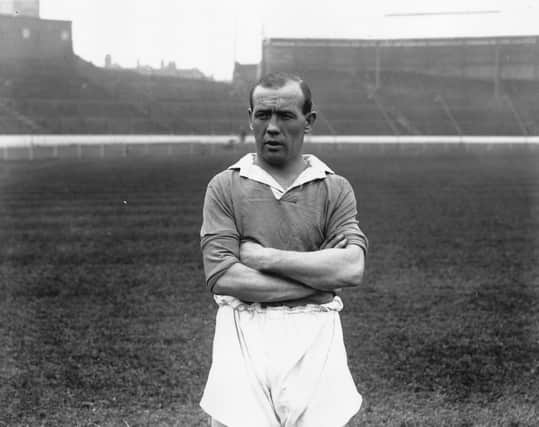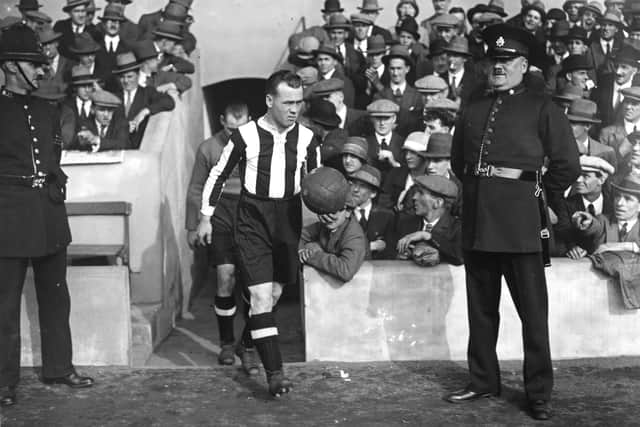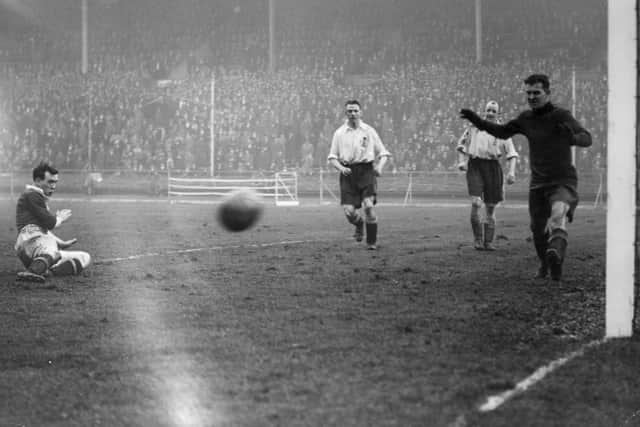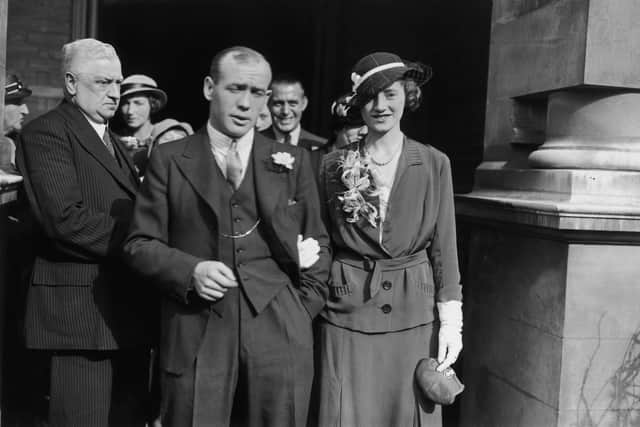Hughie Gallacher: The glory and tragedy of a Newcastle United and Scotland legend


Some of the people he passed on the Durham Road turned to look. Of course they did. The little man had once been to Tyneside what Maradona was to Naples. That had been in another age, though. Then the possibilities for a man of his skill and bravado had appeared limitless. But as time passed and age, alcohol and brutality chewed away his talent, his volcanic self-belief had fizzled and the snappy, sassy Saturday night swagger had become a head-pounding, bird-caged-mouthed Sunday morning lurch. One by one the opportunities evaporated. Now, as he paced about on a footbridge over the east coast railway line, there seemed to Hughie Gallacher only a single option left to him.
As a boy in North Lanarkshire the little man had palled around with another tiny football genius, Alex James. The pair had raced around the streets of Bellshill and Mossend, whooping like Apaches and “kicking anything we could get our hands on”. If it was a ball, so much the better.
Advertisement
Hide AdAdvertisement
Hide AdAt 15 Hughie Gallacher was down in the 180 fathom darkness of Hattonrigg pit. In the daylight, he played for Tannochside Athletic, then Hattonrigg Thistle before moving on to Bellshill Athletic, who had initially rejected the centre forward on grounds of stature. You could see their point. Fully grown, Gallacher stood 5ft 5ins. He had child-sized feet. Evenings, he pummelled the heavy bag in a Hamilton boxing gym. If there’d been weight categories in football he’d have been playing in the bantam division. Yet if others seemed obsessed with his stature, Gallacher appeared oblivious to it. He was as strong in the air, and as quick across the ground, as a man with legs twice the length; as hard to knock over as a sumo wrestler. His dazzling ball skills had been honed through long monkish hours of fanatical practice. He could pass with intelligent accuracy and shoot with booming power.


In December 1920 Gallacher appeared for a Scottish junior side against Ireland in Glasgow, bagging the equaliser in a 1-1 draw. Watching from the stands was James Jolly of Queen of the South, a club formed a few years earlier and ambitious for League status. Jolly offered Gallacher £5 a week to play for Queens. He made his debut at Palmerston Park on January 29, 1921, scoring four times in a 7-0 thrashing of St Cuthbert Wanderers. In the next eight games he belted 15 goals, before collapsing with double pneumonia.
While convalescing at home in Bellshill, Gallacher was poached by Airdrieonians, signing his contract – so legend has it – on a coffin in the back room of a local undertakers. In 111 games for the Diamonds he would hit 91 goals, helping them to four consecutive second place finishes in the league and victory in the 1924 Scottish Cup final, the club’s only major silverware.
Maddened by his impudence, defenders whacked lumps out of the little centre forward. Despite his home-made, reinforced shin pads, his legs were riven with scars, corrugated with welts, blued with bruises – an atlas of the world of pain. In the dressing room at half-time he sucked on Woodbines, blood bubbling through the tongue of his boots. He kicked back too. He stuck his elbows in. He raked shins and calves. “He had more tricks than a bucketful of monkeys,” winced England keeper Frank Swift after Gallacher had repeatedly stamped on his feet.
Pugnacity came naturally to Gallacher, He had a Rabelaisian appetite for conflict. His body was too small to contain the fury within him. As a teenager he incensed his Ulster Orangeman father by supporting Celtic and marrying a Bellshill Catholic, Anne McIlvaney. He upset team mates by berating them for their failures. He drank heavily, fought often, told club directors exactly what he thought of them. In Belfast he was shot at by a sniper. Asked who might want to kill their star striker, the Scottish selectors shook their heads – it would be quicker to name those who didn’t.


Trouble surrounded Gallacher as a nimbus does a saint but his talent was irresistible. Shortly before Christmas 1925, Newcastle United signed him from Airdrieonians – whose fans threatened to burn down Broomfield Park in protest – for a fee of £6,500. Gallacher’s arrival on Tyneside had been a cause of excitement and expectation but when his new team mates met him for the first time they rubbed their eyes in disbelief: the directors had broken the club record transfer for this midget? The fans muttered the same when they saw the striker run out for his debut against Everton four days later, but in the 30th minute he received the ball with his back to goal, swivelled as if on rollers, steamed between two defenders and slapped a shot past the keeper. In the blink of an eye the Geordies had a new idol. Gallacher slammed in 13 goals in his first seven matches and in the final game of the season bagged a hat-trick.
Newcastle made him captain for the 1926/27 season. St James’ Park was packed for every match. The team – quite often made up of ten Scots and a Welshman, Ed Wood – had been strong and workmanlike, top half of the table. Gallacher made it irresistible. He inspired his club mates, fired up the crowd, terrorised and riled the opposition. He struck four goals in the opening match against Aston Villa and never let up, scoring 36 times in 38 league appearances. United won the league by five points. Their first title in close on two decades. Looking back, club secretary Frank Watt – the man who had signed him – named Gallacher “the greatest player the game has ever known”. In the 1950s an unnamed team mate told that celebrated chronicler of North East football, Arthur Appleton, that, “Hughie was the Daddy of them all”. Every man who had played alongside him, Appleton recorded, spoke of his abilities with “almost awesome respect”. This was gushing talk back then.
Adored by the fans and flush with backhanders and win bonuses, Gallacher rolled around Tyneside dressed in trilby hats, double-breasted suits and spats. Photos show a pug-featured bloke with wiry hair, his chin tucked in like a prize-fighter’s. His eyes glisten between lowered lids, he has a smile that contains more challenge than cheer: Jimmy Cagney’s harder brother.
Advertisement
Hide AdAdvertisement
Hide AdHe had long since abandoned Anne and his son Jack (who would be a prodigious goalscorer, too) and now took up with Hannah Anderson, the serenely lovely teenage daughter of a Tyneside publican. It was love but her family disapproved. Gallacher was arrested after a fight with her brother in the shadow of the High Level Bridge.


And so it went on: as Cagney says in The Roaring Twenties: “This brawl’s gonna last forever”. Midway through the 1927/28 season the Scot was suspended for two months by the English FA after shoving referee Bert Fogg into a bath following a game at Huddersfield. Without him, United slumped. They did not come close to retaining their title. They have not won it since.
It might have been different. During his suspension Gallacher – banned from training – returned to Bellshill and was picked for Scotland in the celebrated Wembley Wizards match (remarkably he didn’t score in that storied 5-1 win). He caught up with his old pal, Alex James. A once in a generation playmaker, James was earning a crust at Preston North End in the English second tier. He wanted to step up. He wanted to join his mate on Tyneside. Excited, Gallacher laid the idea before United’s directors. He and James were in perfect harmony on the field. They would play six times together for Scotland, win every game and net 12 goals between them. Bringing that to St James’ Park would be a stroke of genius. Alas, with that mix of witless complacency and epic stupidity that seems to float around the St James’ Park boardroom like an airborne fungus, the directors rejected the proposal out of hand. A year later, James joined Herbert Chapman’s Arsenal, leading them to four league titles and two FA Cups. The sliding doors had shut at St James’ Park.
By the time James was making his Highbury debut, Gallacher was standing before an FA panel to answer charges of being drunk and disorderly during one of Newcastle’s pre-season fixtures in Hungary. The centre forward’s boozing before matches might have become the stuff of Tyneside folklore, but it upset the authorities and his paymasters. In the summer of 1930, while Gallacher was on tour with Scotland, Newcastle’s new manager, Andy Cunningham, sold him to Chelsea without his knowledge.
In London things rolled on as before. Gallacher netted a brace on his Stamford Bridge debut, was questioned by the coppers after fighting with Fulham fans, threatened to strike over wages and was found dropdown drunk the night before a match with Derby. Chelsea were big spenders but the team never gelled and off the pitch Gallacher’s life was unspooling. Desperate to marry Hannah, he begged his wife for a divorce. The Roman Catholic Annie refused. Gallacher pursued the matter through the courts. Legal fees and high living chomped through his cash. By the time the decree absolute came he had been declared bankrupt with a debt of £787. When Derby County bought him from Chelsea for £2,750 in October, 1934, £200 of his signing-on fee was paid straight to the court.
After that it was a slow descent, the transfer fees and bonuses a little less fat each time as Gallacher’s legs grew slower. He joined Division Three (South) Notts County for £2,000 in 1936, then moved back to the top flight with Grimsby Town for £1,000 in 1937. A year later, he returned to Tyneside to play for Gateshead, struggling at the bottom of Division Three (North). He was happy to be back and people were glad to have him. Twenty thousand packed into Redheugh Park to watch his debut. He scored 18 times for Gateshead in 31 appearances, then Hitler invaded Poland and his career as a footballer was finished.
Gallacher found work as a labourer. For a time he wrote articles in the local press, but his outspoken views aggravated the ever thin-skinned Newcastle board and he was banned from the St James’ Park press box. In 1951 Hannah, the love of his life, died of a heart attack, leaving Gallacher with three sons to bring up alone.
By 1957 Gallacher was living with the boys in Sheriff Hill, working for a cobbler. One May evening he returned home from the pub. His youngest son Matthew, aged 14, greeted his dad with a sarcastic remark. Gallacher snapped and threw an ashtray at him. Blood running from a cut on his head, Matthew ran out into the street. Neighbours called the police. Gallacher was arrested and charged with assault, ill-treatment and child neglect (allegations the sons say were totally unfounded).
Advertisement
Hide AdAdvertisement
Hide AdMatthew went to live with his aunt. Hughie returned to an empty house. His friends assured him that everything would work out, former team mates offered to appear as character witnesses. Nothing anyone said could lift the darkness.
Gallacher was due to appear before Gateshead Magistrates on Wednesday June 12th. On the Tuesday morning he wrote a letter to the court apologising for all the problems he had caused and left his house for the last time.
For a while Gallacher paced around on the Belle Vue Bank footbridge. Looking north, he could see the floodlights of Saint James’ Park where a record crowd of 68,386 had turned out to cheer him when he returned with Chelsea. Then, the once quenchless fight in him finally doused, he descended the wooden steps. It was just gone noon. The Edinburgh express was thundering north past Pelaw Grange dog track. Hughie Gallacher stepped out onto the tracks to meet it.
Harry Pearson writes for When Saturday Comes and his latest book, The Farther Corner - A sentimental return to North-East football, is out now. This article first appeared in Issue 19 of Nutmeg, a long-form quarterly publication devoted entirely to every aspect of Scottish football. Available from www.nutmegmagazine.co.uk